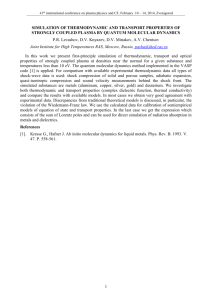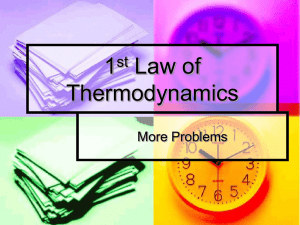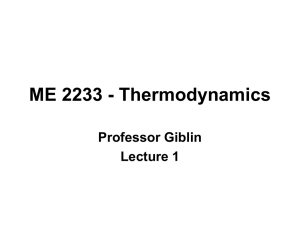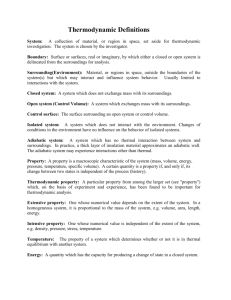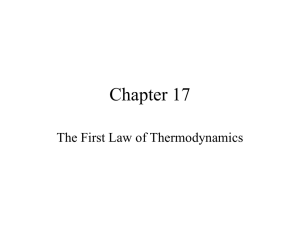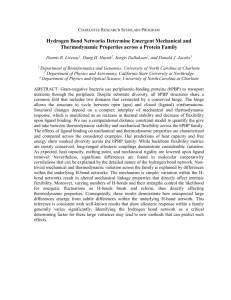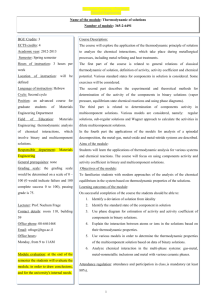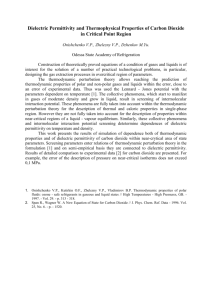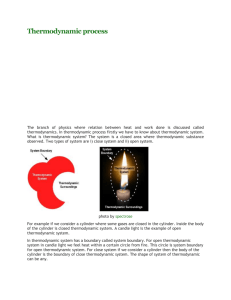thermodynamics adiabatic
advertisement
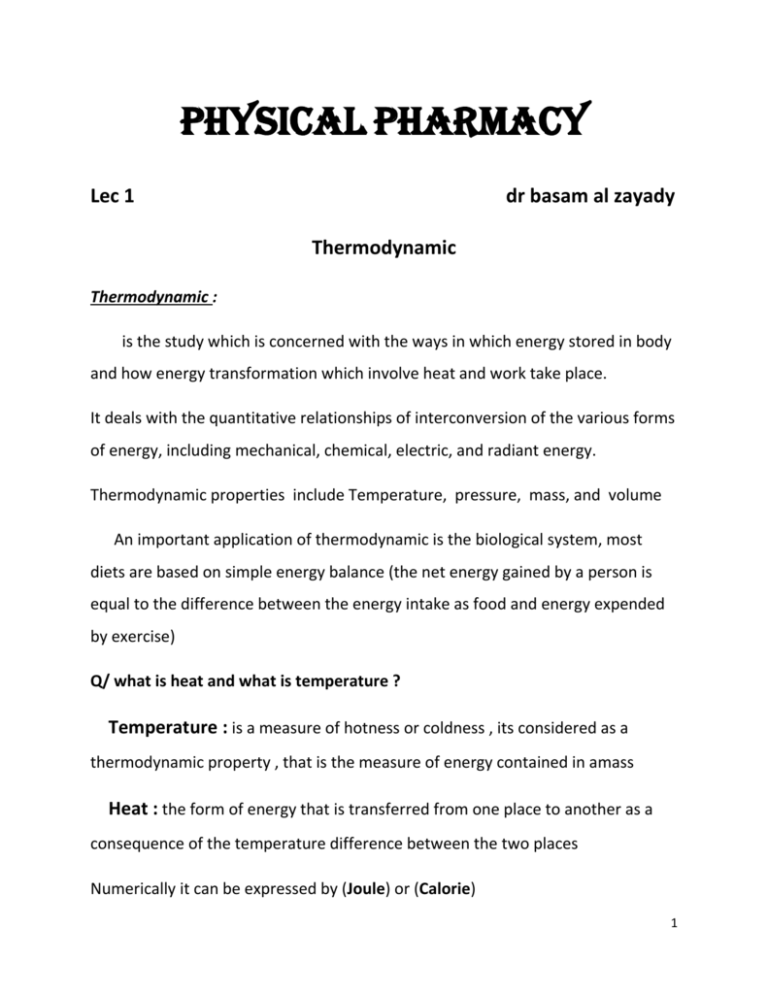
Physical pharmacy Lec 1 dr basam al zayady Thermodynamic Thermodynamic : is the study which is concerned with the ways in which energy stored in body and how energy transformation which involve heat and work take place. It deals with the quantitative relationships of interconversion of the various forms of energy, including mechanical, chemical, electric, and radiant energy. Thermodynamic properties include Temperature, pressure, mass, and volume An important application of thermodynamic is the biological system, most diets are based on simple energy balance (the net energy gained by a person is equal to the difference between the energy intake as food and energy expended by exercise) Q/ what is heat and what is temperature ? Temperature : is a measure of hotness or coldness , its considered as a thermodynamic property , that is the measure of energy contained in amass Heat : the form of energy that is transferred from one place to another as a consequence of the temperature difference between the two places Numerically it can be expressed by (Joule) or (Calorie) 1 If two bodies are in thermal equilibrium with a third body , they are in thermal equilibrium with each other , this simple fact is known as (Zeroth law) Note : the work of thermometer depends upon this law A thermodynamic system is simply defined as a quantity of matter or a region in space chosen for study The region outside the system is called (surrounding) The physical (or virtual) barriers that separate the system from its surrounding is called (Boundary) It is useful at this point to distinguish the attributes of the three types of systems that are frequently used to describe thermodynamic properties: 1/ open system : can exchange both energy and matter with its surrounding 2/ closed system : can exchange energy but not matter with its surrounding 3/ isolated system : that cant exchange neither matter nor energy . For instance, if two immiscible solvents, water and carbon tetrachloride, are confined in a closed container and iodine is distributed between the two phases, each phase is an open system, yet the total system made up of the two phases is closed because it does not exchange matter with its surroundings. 2 Fig. Examples of thermodynamic systems. (a) An open system exchanging mass with its surroundings; (b) a closed system exchanging work with its surroundings; (c) a closed system exchanging heat with its surroundings; (d) an isolated system, in which neither work nor heat can be exchanged through boundaries. 3 There are many kinds of processes that can be carried out in thermodynamic system 1- Isothermal process: are those processes in which the system is maintained at a constant temperature , the isothermal system requires either open or closed system An isothermal reaction may be carried out by placing the system in a large constant-temperature bath so that heat is drawn from or returned to it without affecting the temperature significantly. 2- Adiabatic process : is the one in which no heat enter or leave the system , this process require an isolated system and the temperature of the system may be changed A reaction carried on inside a sealed Dewar flask or “vacuum bottle” is adiabatic because the system is thermally insulated from its surroundings. 3- Spontaneous process : is the one that occur naturally and take place with out intervention ( ex. If a filled balloon is punctured , much of the contained gas is transferred to the atmosphere) Thermodynamics is based on three “laws” or facts of experience that have never been proven in a direct way, in part due to the ideal conditions for which they were derived. Various conclusions, usually expressed in the form of mathematical equations, however, may be deduced from these three principles, and the results consistently agree with observations. 4 First Law of Thermodynamics The first law is a statement of the conservation of energy. It states that, although energy can be transformed from one kind into another, it cannot be created or destroyed. Put in another way, the total energy of a system and its immediate surroundings remains constant during any operation. This statement follows from the fact that the various forms of energy are equivalent, and when one kind is formed, an equal amount of another kind must disappear. The relativistic picture of the universe expressed by Einstein's equation Energy = (mass change) * (velocity of light)² suggests that matter can be considered as another form of energy, 1 g being equivalent to 9 × 1013 joules. These enormous quantities of energy are involved in nuclear transformations but are not important in ordinary chemical reactions. According to the first law, the effects of Q (heat absorbed ) and W (work) in a given system during a transformation from an initial thermodynamic state to a final thermodynamic state are related to an intrinsic property of the system called the internal energy, defined as ∆E =E2-E1 = Q+W where E2 is the internal energy of the system in its final state and E1 is the internal energy of the system in its initial state. The change in internal energy ΔE is related to Q and W transferred between the system and its surroundings the equation 5 also expresses the fact that work and heat are equivalent ways of changing the internal energy of the system. Work of Expansion Against a Constant Pressure We first discuss the work term. Because of its importance in thermodynamics, initial focus is on the work produced by varying the volume of a system (i.e., expansion work or compression work) against a constant opposing external pressure, Pex. Imagine a vapor confined in a hypothetical cylinder fitted with a weightless, frictionless piston of area A. If a constant external pressure Pex is exerted on the piston, the total force is Pex × A because P = Force/Area. The vapor in the cylinder is now made to expand by increasing the temperature, and the piston moves a distance h. The work done against the opposing pressure in one single stage is W=- Pex x A x h Now A × h is the increase in volume, ΔV = V2 - V1, so that, at constant pressure, W=- p ∆V = - Pex (v2 –v1) 6

